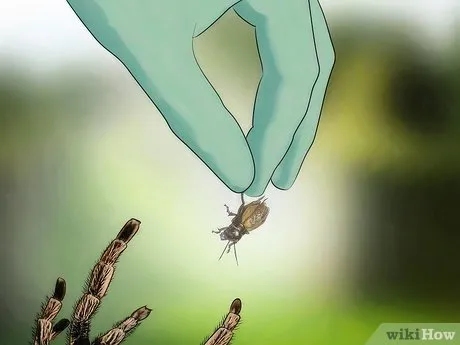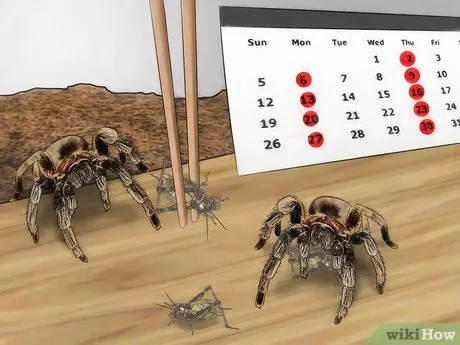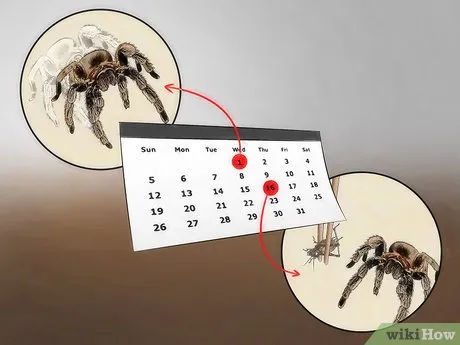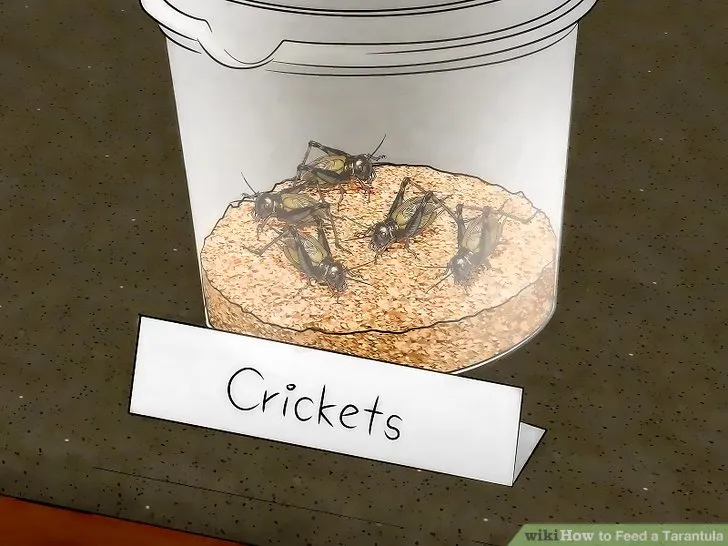Caring for a tarantula sling, the juvenile stage of these fascinating creatures, is a rewarding experience. One of the most crucial aspects of tarantula sling care is understanding how often to feed them. This guide provides a comprehensive overview of the feeding needs of tarantula slings, ensuring their healthy growth and development. Providing the right food at the right time is essential for their well-being. We will delve into the factors that influence feeding frequency, how to identify hunger cues, the best food choices, and how to troubleshoot common feeding issues. Following these guidelines will help you become a successful tarantula sling owner.
Understanding Tarantula Slings Feeding Needs
Tarantula slings have specific dietary requirements that change as they grow. The frequency of feeding is a dynamic aspect of tarantula care, influenced by a variety of factors. These creatures are voracious eaters in their juvenile stage, and regular feeding is vital for their development. However, overfeeding can lead to health issues, so it’s crucial to strike the right balance. A well-fed sling will grow faster, molt more frequently, and exhibit vibrant colors. Understanding these fundamental feeding needs forms the basis of providing the best care for your tarantula sling and contribute to a happy and healthy life.
Factors Influencing Feeding Frequency
Several factors affect how often you should feed your tarantula sling. These factors include species-specific requirements, temperature, the size and stage of the sling, and the environmental conditions within the enclosure. Recognizing these influences will allow you to adjust the feeding schedule to match the individual needs of your sling, optimizing its growth and well-being. Every tarantula is unique, therefore, there is no one-size-fits-all approach. Careful observation and adaptation are critical components of tarantula sling care. By understanding these factors, you can create an optimal feeding plan that ensures a healthy life for your pet.
Species-Specific Feeding Requirements

Different tarantula species have varying metabolisms and growth rates, influencing their feeding needs. Some species, such as the fast-growing Psalmopoeus genus, may require more frequent feeding than slower-growing species like Grammostola. Researching the specific needs of your tarantula species is essential. Some species may readily consume food while others can be picky eaters, and this varies greatly from species to species. This research will help you determine the ideal feeding schedule for your specific tarantula sling. The temperament of your sling is also something to consider. This knowledge will allow you to adjust feeding schedules to meet the individual needs of your pet.
Temperature and Its Impact
Temperature significantly affects a tarantula sling’s metabolism and appetite. Warmer temperatures generally speed up metabolism, leading to a greater need for food and more frequent molting. Conversely, cooler temperatures slow down metabolism, reducing the need for food. Maintain the appropriate temperature range for your specific species. If the temperature drops, you might reduce feeding frequency; if the temperature is warmer, you can increase it. Ensure that the heating setup does not create a hazard. Proper temperature control is crucial for maintaining an optimal environment for your sling. Temperature fluctuations will also impact the feeding behavior, so a close monitoring is very important.
Size and Stage of the Sling
The size and developmental stage of your tarantula sling also dictate its feeding requirements. Smaller slings need more frequent feeding, sometimes every other day or every three days, because they are actively growing and have higher energy demands. As they grow and molt, their feeding frequency may decrease. Adjust the feeding schedule based on the size and appearance of your sling. Larger slings, closer to the juvenile or sub-adult stage, can often be fed less frequently, perhaps once a week or even less. Observation is important; a well-fed sling will have a rounded abdomen, and the absence of food refusal suggests proper feeding. The size of the food item must also be considered.
Environmental Conditions

Humidity, enclosure size, and overall stress levels can also influence how often you should feed your tarantula sling. High humidity levels may increase metabolism. A larger enclosure might require slightly more food if the sling is actively exploring. Minimizing disturbances and ensuring a stress-free environment is critical for encouraging feeding. Provide adequate ventilation and ensure your sling has access to clean water. Stress and other external factors may lead to a change in feeding habits. Careful monitoring of environmental factors contributes to the health and well-being of your tarantula sling. Adjust the feeding routine to address changes in its surroundings.
Identifying Hunger Cues in Tarantula Slings
Learning to recognize hunger cues is essential for responsible tarantula sling care. Identifying these signs helps you avoid overfeeding or underfeeding, optimizing your sling’s growth and health. The ability to identify when your sling is hungry will help to create the correct feeding schedule. The goal is to provide the correct amount of food. Being able to observe the feeding patterns of your tarantula sling will allow you to make better feeding decisions.
Recognizing a Hungry Sling
A hungry tarantula sling often displays active hunting behavior. They may actively stalk their enclosure, exploring every corner. Look for the sling to be alert and responsive to movement, especially when food items are introduced. If the sling quickly seizes and consumes prey, this indicates it’s ready for a meal. A slightly flattened abdomen is also a sign it’s ready to eat. These signs tell you that your sling is hungry and can handle another feeding.
Signs of Overfeeding

Overfeeding is as detrimental as underfeeding. A tarantula sling showing signs of an excessively plump abdomen, or repeatedly refusing food, may be overfed. If your sling consistently rejects offered food items, or shows a lack of interest in hunting, you may need to reduce the feeding frequency. Another sign is a lack of appetite. Overfeeding can stress the tarantula and lead to other health problems. Observing your sling’s behavior and adapting your feeding schedule accordingly ensures its well-being. Avoid the temptation to overfeed, as it can lead to serious health complications, including a shorter lifespan.
Choosing the Right Food for Your Sling
Selecting appropriate food items is crucial for the health and development of your tarantula sling. The right food not only provides essential nutrients but also stimulates natural hunting behaviors. The size and type of food will change as the tarantula grows. A balanced diet contributes to overall health. Choosing the proper food and size is critical to your sling’s survival. Knowing what to feed and when will help you develop a good feeding program. Providing the right food will ensure a long and healthy life.
Appropriate Food Items
The primary food source for tarantula slings should be live insects. Small crickets, flightless fruit flies, and pinhead crickets are excellent choices for younger slings. As they grow, you can introduce larger prey items like small roaches or even appropriately sized mealworms. Ensure that the food items are gut-loaded before feeding to your tarantula sling. This provides the sling with more nutritional value. Providing a variety of food items helps to ensure a balanced diet, which is important to the overall health of the sling.
Food Size and Feeding Frequency

The size of the food item should be appropriate for your sling’s size; it should be no larger than the tarantula’s body length. For smaller slings, it is usually recommended to feed them a small insect every other day or every three days. As they grow, you can feed them larger prey less frequently, such as once or twice a week. The goal is to provide a food item that is manageable for the sling to capture and consume easily. It is best to remove uneaten food within 24 hours to prevent stress and potential health problems.
Preparing Food Items
Before feeding, you should gut-load the feeder insects. This is done by feeding the insects a nutritious diet for 24-48 hours before you offer them to your sling. This process increases the nutritional value of the food item. Ensure that the food insects are pesticide-free. Remove any uneaten food items from the enclosure within 24 hours to prevent stress. Always use tongs when feeding to minimize the risk of your tarantula sling escaping or the insects hiding in the enclosure. By taking the proper precautions, your tarantula sling will thrive.
Setting Up the Feeding Environment
A proper feeding environment minimizes stress and makes feeding easier. An ideal environment will reduce the risk of escapes and ensure the health and well-being of your tarantula sling. Ensuring that the environment is correct will aid in the health and happiness of your sling. Establishing a consistent routine and providing a safe and clean environment will contribute to a healthy tarantula.
Best Practices for Feeding

Use tongs to offer food items to your tarantula sling. This will help you avoid getting bitten and minimize any risk of escape. Provide a shallow water dish with fresh, clean water at all times. Place the food item near the sling, but not directly on top of it, allowing the sling to hunt. Feed in the evening or at night, as tarantulas are nocturnal. Keep the enclosure clean and free of any waste. By implementing these practices, your tarantula sling will be happy and healthy.
Removing Uneaten Food
Uneaten food can stress your tarantula sling and attract unwanted pests. Remove uneaten prey within 24 hours of feeding. This helps prevent mold growth and potential disease. Regularly inspect the enclosure for uneaten food items. If you find uneaten food, remove it immediately. Using tongs can help in this process. Removing uneaten food creates a cleaner and safer environment for your sling. A clean enclosure is a healthy enclosure, leading to a healthy tarantula.
Troubleshooting Feeding Issues
Even with the best care, feeding issues can sometimes arise. Identifying and addressing these problems quickly helps ensure the health and well-being of your tarantula sling. Being able to address these problems will enable your sling to thrive and lead a long and happy life. Learning how to address any problems is essential for a successful tarantula owner.
Refusal to Eat

If your tarantula sling refuses to eat, first check its environment and ensure the temperature and humidity are appropriate. Verify there are no disturbances to the sling. Is it molting? Is it getting ready to molt, and not interested in eating? If these factors seem to be alright, you may need to adjust the feeding schedule or the size of the prey. Sometimes, slings simply are not hungry and do not want to eat. If the refusal persists, consult with an experienced tarantula keeper or a veterinarian. Correcting this behavior may improve the overall health of your tarantula sling.
Molting and Feeding
Tarantulas typically stop eating before a molt. Do not offer food during the molting period. If your tarantula is in premolt, it will likely refuse food, and this is normal. Premolt behavior often involves a darkening of the abdomen. After molting, wait a few days before offering food, allowing the tarantula’s new exoskeleton to harden. Molting is a natural process, and understanding this will prevent unnecessary worry. The post-molt period is a very vulnerable time for your tarantula. Patience is essential when dealing with molting and feeding. A healthy molt leads to a healthy tarantula.
Final Thoughts
Understanding how often to feed a tarantula sling is a crucial part of providing proper care. By considering factors such as species, temperature, size, and behavior, you can create a feeding schedule that promotes healthy growth and development. Always prioritize your sling’s well-being, observe its behavior, and make adjustments as needed. With careful observation, proper food selection, and a consistent feeding routine, you will be able to enjoy the fascinating world of tarantula keeping. By implementing the information in this guide, you can give your tarantula sling the best life possible.
